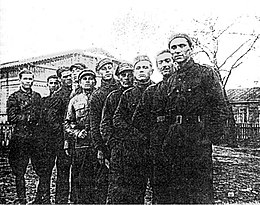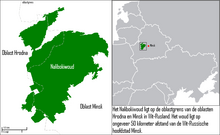| Revision as of 02:28, 28 February 2023 view sourceGitz6666 (talk | contribs)Extended confirmed users9,519 edits editingTag: Visual edit← Previous edit | Revision as of 02:29, 28 February 2023 view source Gitz6666 (talk | contribs)Extended confirmed users9,519 edits maybe "wrongly" is better than "falsely"?Tag: Visual editNext edit → | ||
| Line 39: | Line 39: | ||
| == Allegations of Jewish involvement in the massacre == | == Allegations of Jewish involvement in the massacre == | ||
| Allegations that the Jews played a role in the massacre began to circulate in the early 2000s, when the local branch of a right-wing organisation of Polish Canadians, the ], |
Allegations that the Jews played a role in the massacre began to circulate in the early 2000s, when the local branch of a right-wing organisation of Polish Canadians, the ], wrongly claimed that in "] and Naliboki Jewish partisans boast of killing 300 and 130 Poles respectively."<ref>{{Cite web |date=23 June 2001 |title=CPC Toronto District - Viewpoints. LETTERS TO BOOKS. |url=http://www.kpk-toronto.org/wp-content/uploads/viewpoints_020.html |archive-url=http://web.archive.org/web/20220907182445/http://kpk-toronto.org/wp-content/uploads/viewpoints_020.html |archive-date=7 September 2022 |access-date=27 February 2023 |website=Canadian Polish Congress. Toronto District}}</ref><ref name="G&K">{{Cite journal |last=Grabowski |first=Jan |author-link=Jan Grabowski |last2=Klein |first2=Shira |date=2023 |title=Misplaced Pages’s Intentional Distortion of the History of the Holocaust |url=https://www.tandfonline.com/doi/full/10.1080/25785648.2023.2168939 |journal=] |pages=19-20 |doi=10.1080/25785648.2023.2168939}}</ref> At the request of the Canadian Polish Congress, in 2001 the Polish government-affiliated ] launched an investigation into massacres of Poles allegedly carried out by Jews, including the Naliboki massacre.<ref name="G&K" /><ref>{{Cite web |last=Perelman |first=Marc |date=August 8, 2003 |title=Poles Open Probe Into Jewish Role In Killings |url=https://forward.com/news/7832/poles-open-probe-into-jewish-role-in-killings/ |access-date=2023-02-27 |website=] |language=en}}</ref><ref name="citinet">{{Citation |author=IPN |title=Investigation Reports on Koniuchy and Naliboki |date=1 March 2002 |url=http://www.citinet.net/ak/polska.php?Page=66&Lang=EN |archive-url=https://web.archive.org/web/20110723042847/http://www.citinet.net/ak/polska.php?Page=66&Lang=EN |publisher=Institute of National Memory |access-date=19 January 2014 |archive-date=23 July 2011}}</ref> Following the release of the film '']'' in 2008, the allegation that a unit of ], the ], participated in the massacre was reported in the media and debated by historians;<ref name="Wyborcza_movie">{{Cite web |date=16 June 2008 |title=A Hollywood Movie About Heroes or Murderers? |url=https://wyborcza.pl/7,76842,5316759,a-hollywood-movie-about-heroes-or-murderers.html?disableRedirects=true |access-date=2023-02-28 |website=]}}</ref><ref>{{Cite news |last=Warsaw |first=Kamil Tchorek in |date=31 December 2008 |title=Country split over whether Daniel Craig is film hero or villain |language=en |work=] |url=https://www.thetimes.co.uk/article/country-split-over-whether-daniel-craig-is-film-hero-or-villain-3fg9ktfl6qc |access-date=2023-02-28 |issn=0140-0460}}</ref> the Polish nationalist press and websites denounced the attempt at glorifying a group of "] bandits."<ref name="Wyborcza_movie" /> According to a 2008 press release by the Institute for National Remembrance, some eye-witnesses had reported that the massacre had been carried out by Bielski partisans, but subsequent historical research had found no documentary evidence to support these testimonies.<ref name="Komunikat_2008">{{Cite web |last= |first= |date=19 June 2008 |title=Komunikat dot. śledztwa w sprawie zbrodni popełnionych przez partyzantów sowieckich w latach 1942–1944 na terenie byłego województwa nowogródzkiego |url=https://ipn.gov.pl/pl/dla-mediow/komunikaty/10278,Komunikat-dot-sledztwa-w-sprawie-zbrodni-popelnionych-przez-partyzantow-sowiecki.html?fbclid=IwAR2_bzQIP5HdXQPg4ARnUp-PkxnR-4NcJZuT_1GGrHhkcZz2-eIHlg70zFs |access-date=2023-02-28 |website=] |language=pl}}</ref> As reported by the Institute, the massacre was carried out by partisans from the "Stalin" Brigade and also from the "Dzerzhinsky", "Bolshevik", "Suvorov" units.<ref name="Komunikat_2008" /> | ||
| ==See also== | ==See also== | ||
Revision as of 02:29, 28 February 2023
1943 massacre of Poles
| Naliboki massacre | |
|---|---|
 Naliboki self-defence unit Naliboki self-defence unit | |
| Location | Naliboki, German-occupied Poland |
| Date | May 8, 1943 |
| Weapons | Automatic and semi-automatic weapons |
| Deaths | 129 |
| Victims | Poles |
| Perpetrators | Soviet |
The Naliboki massacre (Template:Lang-pl) was the 8 May 1943 mass killing of 129 Poles, including women and children, by Soviet partisans in the small town of Naliboki in German-occupied Poland (the town is now in Belarus).
Background
Before the 1939 German-Soviet invasion of Poland, Naliboki was part of eastern Poland's Stołpce County, Nowogródek Province.

Following Operation Barbarossa, Germany's invasion of the Soviet Union, Soviet resistance forces operated in eastern Poland, behind German lines. Since the spring of 1942, the 125th "Stalin" unit operated in the Naliboki forest. Its first documented action was the destruction of a detachment of German police near Naliboki on June 9, 1942. In addition to them, two other Soviet partisan units operated in the Nalibok forest: the Nikitin's unit and the "Chkalov" unit. Local partisans were recruited from Red Army soldiers of all ethnicities who had been cut off by German encirclements, and from Ukrainians and pro-Soviet Belarusians. These troops had no contact with the Central Headquarters of the Partisan Movement (CSPD), limited their attacks on German units for lack of ammunition, and raided nearby villages for supplies. They forcibly took provisions from villagers, whom they treated as enemies. The murder of peasants by way of terrorizing them into giving up provisions began in 1943 when villages such as Kamień, Derewno, Borowikowszczyzna, Dziagwie, and Rodziewszczyzna were raided. Naliboki was among the raided villages. Consequently, in August 1942, by order of the Germans, the villagers formed a self-defense unit, and the village police station was opened. Both the local self-defense and police were infiltrated by the Home Army.
In the spring of 1943, NKVD leaders were sent to Soviet partisans by CSPD, and the partisans were airdropped material. They were led by Vasily Chernyshov [ru] "Platon" who, equipped with a radio station, reached the Naliboki forest in April, where he took command of the entire partisan movement in the Baranovichi oblast. In May, there were more than 5,000 partisans under his command, divided into 36 divisions and 4 brigades, most of them operating in the Naliboki forest.
In March and April 1943 the Soviet partisans arranged two meetings with the Polish self-defense leaders. During the talks, the Soviet partisans insisted that the Poles join them, but the Poles refused. However, an agreement was signed with the Poles, who were represented by Eugeniusz Klimowicz, concerning a truce and joint operations against robbers hiding in the forest. The Soviet partisans violated the truce and decided to atack Naliboki.
The massacre

In the early morning of 8 May 1943, Soviet partisans raided Naliboki. According to Chernyshov's report, the "Dzerzhinsky" unit, the "Bolshevik" unit and the "Suvorov" unit took part in the assault, and were commanded by the commander of the "Stalin" brigade. Naliboki's self-defense was outnumbered, with only 26 rifles and 2 light machine guns. However, the policemen managed to barricade themselves in the station, located in an unfinished church building, and retreated in the evening after the Soviet partisans left, despite heavy losses.
A few of the Soviet attackers, including a political officer, were killed by the defenders. Polish men were dragged from their homes and shot individually or in small groups. Mass looting followed. Many farmhouses were set on fire. Also killed during the Soviet attack were three Polish women, several teenagers, and a ten-year-old boy. The town's church was set on fire, along with the public school, fire station, and post office. The raid took two to three hours.
The Soviet commander reported to the NKVD the killing of 250 people, the capture of weapons, the rounding up of 100 cows and 78 horses, and the destruction of a German garrison. In reality, the number of victims was lower (now estimated at 129), no Germans were present or killed, and only one Belarusian auxiliary policeman happened to be sleeping in the town on the night of the attack.
Aftermatch
The Soviet NKVD persecuted the pro-German Belarusian populace at least as badly as the anti-Nazi Poles. Thousands of Belarusian collaborators were killed, including teachers, local administrators and members of the Belarusian Auxiliary Police, and dozens of Polish communities were destroyed. Resulting from this, on at least ten occasions the Nowogródek District division (pl) of the Armia Krajowa attempted to negotiate with the Soviet partisans to stop the attacks on hapless villages. Those attempts were futile. In May 1943, the entire Polish delegation was murdered by the Soviets in the powiat of Szczuczyn and the pacifications continued. Apart from Naliboki, other massacres were committed in Koniuchy (Koniuchy massacre), Szczepki, Prowżały, Kamień, Niewoniańce, Izabelin, Kaczewo, Babińsk, and Ługomowicze, including murders around Dokudów and near the Narocz and Kromań lakes, as well as in Derewno.
In the cemetery in Naliboki, near the church, which was rebuilt in the 1990s, there is a monument with an inscription in Polish: "In tribute to 127 residents of Naliboki murdered on May 8, 1943 Parishioners." Belarusian authorities have refused to clearly identify the perpetrators of the crime.
Allegations of Jewish involvement in the massacre
Allegations that the Jews played a role in the massacre began to circulate in the early 2000s, when the local branch of a right-wing organisation of Polish Canadians, the Canadian Polish Congress, wrongly claimed that in "Koniuchy and Naliboki Jewish partisans boast of killing 300 and 130 Poles respectively." At the request of the Canadian Polish Congress, in 2001 the Polish government-affiliated Institute of National Remembrance launched an investigation into massacres of Poles allegedly carried out by Jews, including the Naliboki massacre. Following the release of the film Defiance in 2008, the allegation that a unit of Jewish fighters, the Bielski partisans, participated in the massacre was reported in the media and debated by historians; the Polish nationalist press and websites denounced the attempt at glorifying a group of "Jewish-communist bandits." According to a 2008 press release by the Institute for National Remembrance, some eye-witnesses had reported that the massacre had been carried out by Bielski partisans, but subsequent historical research had found no documentary evidence to support these testimonies. As reported by the Institute, the massacre was carried out by partisans from the "Stalin" Brigade and also from the "Dzerzhinsky", "Bolshevik", "Suvorov" units.
See also
References
- Klimowicz, Mieczyslaw (2008). The Last Day of Naliboki: The Untold Story Behind the Massacre. American Literary Press. ISBN 9781934696262.
- pg. 247
- ^ IPN (November 2013). "Śledztwo w sprawie zbrodni popełnionych przez partyzantów radzieckich na żołnierzach Armii Krajowej i ludności cywilnej na terenie powiatów Stołpce i Wołożyn woj. nowogródzkie (S 17/01/Zk)". Śledztwa w biegu - Zbrodnie komunistyczne. Instytut Pamieci Narodowej. Retrieved 25 January 2014.
- Musiał 2009, p. 207-208.
- Musiał 2009, p. 208.
- ^ Kazimierz Krajewski. "Ginęli, ratując Żydów" [Dying while Rescuing Jews] (PDF). „Opor”? „Odwet”? Czy po prostu „polityka historyczna”? O Żydach w partyzantce sowieckiej na Kresach II RP. NR 3 (98), March 2009. Warsaw: IPN Bulletin: 99–120. ISSN 1641-9561. Archived from the original (PDF) on 2016-02-22.
{{cite journal}}:|volume=has extra text (help) - Musiał 2009, p. 208-209.
- ^ Musiał 2009, p. 209.
- ^ Musiał 2009, p. 210.
- Geraldine Bereziuk Lowrey (March 5, 2015). "Book Review". The Last Day of Naliboki By Mieczyslaw Klimowicz (American Literary Press, 2009). The Am-Pol Eagle, Cheektowaga, NY.
At the time, Mieczyslaw Klimowicz, the son of Eugeniusz Klimowicz, was in his teens.
- ^ IPN (1 March 2002), Investigation Reports on Koniuchy and Naliboki, Institute of National Memory, archived from the original on 23 July 2011, retrieved 19 January 2014
- Musiał 2009, p. 211.
- "CPC Toronto District - Viewpoints. LETTERS TO BOOKS". Canadian Polish Congress. Toronto District. 23 June 2001. Archived from the original on 7 September 2022. Retrieved 27 February 2023.
- ^ Grabowski, Jan; Klein, Shira (2023). "Misplaced Pages's Intentional Distortion of the History of the Holocaust". The Journal of Holocaust Research: 19–20. doi:10.1080/25785648.2023.2168939.
- Perelman, Marc (August 8, 2003). "Poles Open Probe Into Jewish Role In Killings". The Forward. Retrieved 2023-02-27.
- ^ "A Hollywood Movie About Heroes or Murderers?". Wyborcza. 16 June 2008. Retrieved 2023-02-28.
- Warsaw, Kamil Tchorek in (31 December 2008). "Country split over whether Daniel Craig is film hero or villain". The Times. ISSN 0140-0460. Retrieved 2023-02-28.
- ^ "Komunikat dot. śledztwa w sprawie zbrodni popełnionych przez partyzantów sowieckich w latach 1942–1944 na terenie byłego województwa nowogródzkiego". Instytut Pamięci Narodowej (in Polish). 19 June 2008. Retrieved 2023-02-28.
Bibliography
- Musiał, Bogdan (2009). Sowjetische Partisanen 1941-1944: Mythos und Wirklichkeit (in German). Ferdinand Schöningh.
External links
Categories: